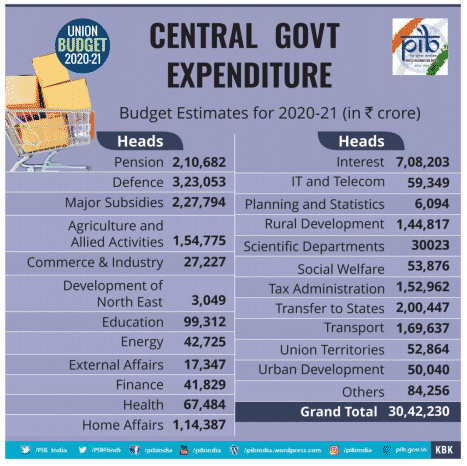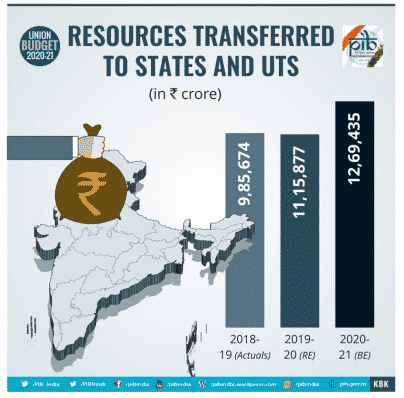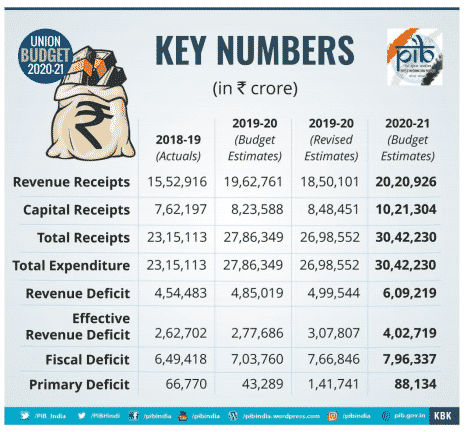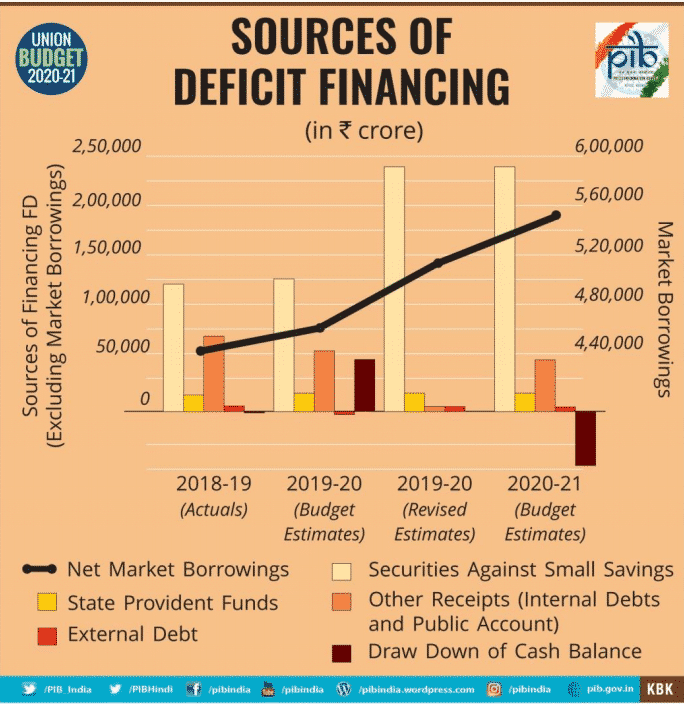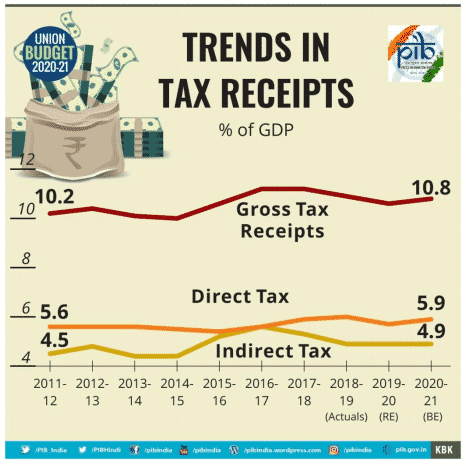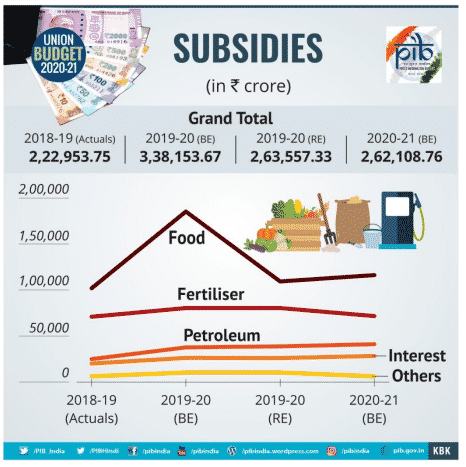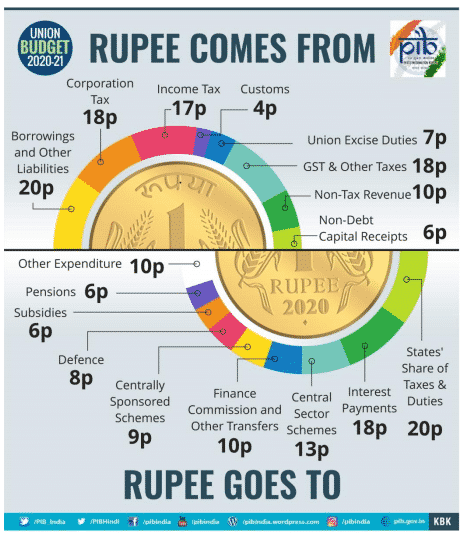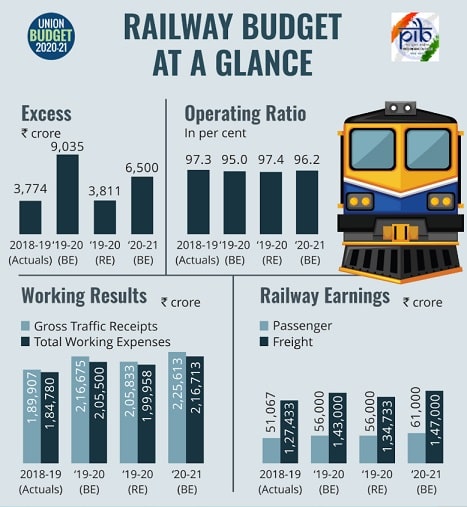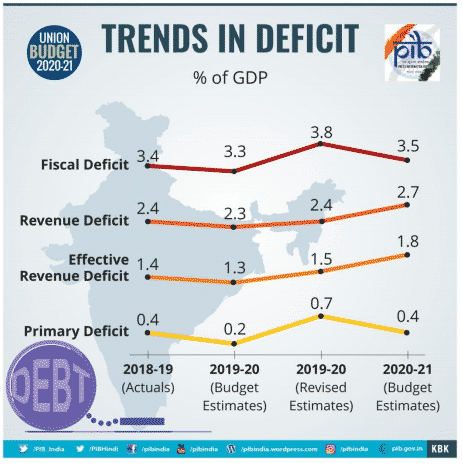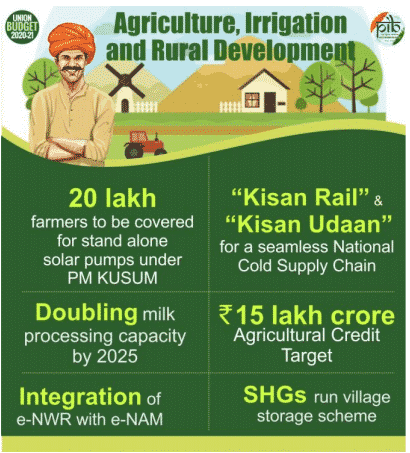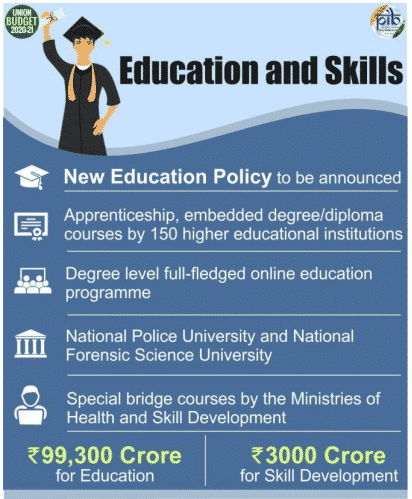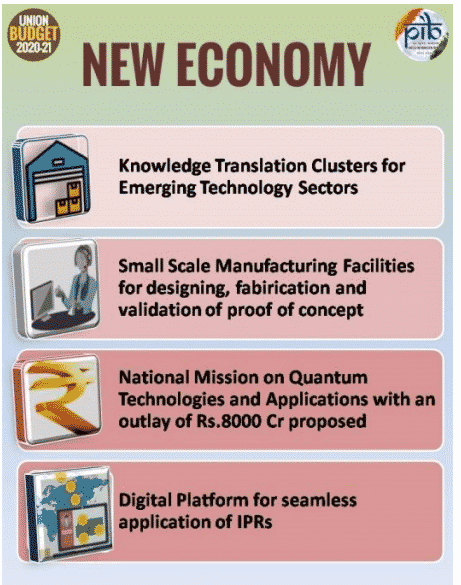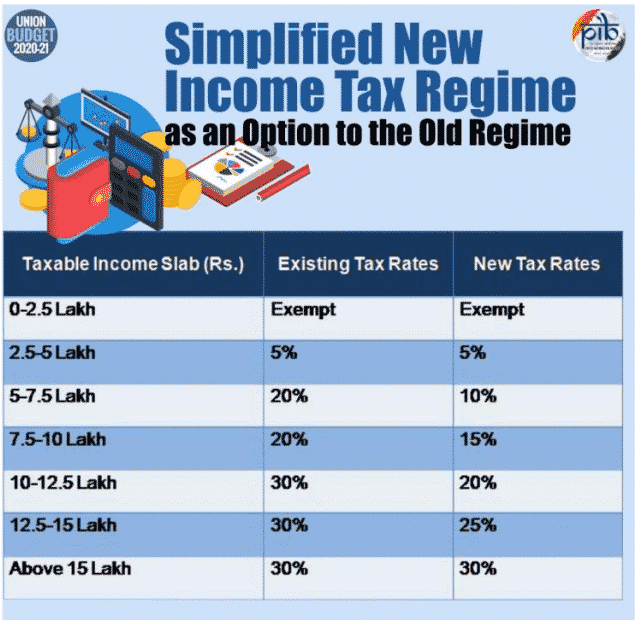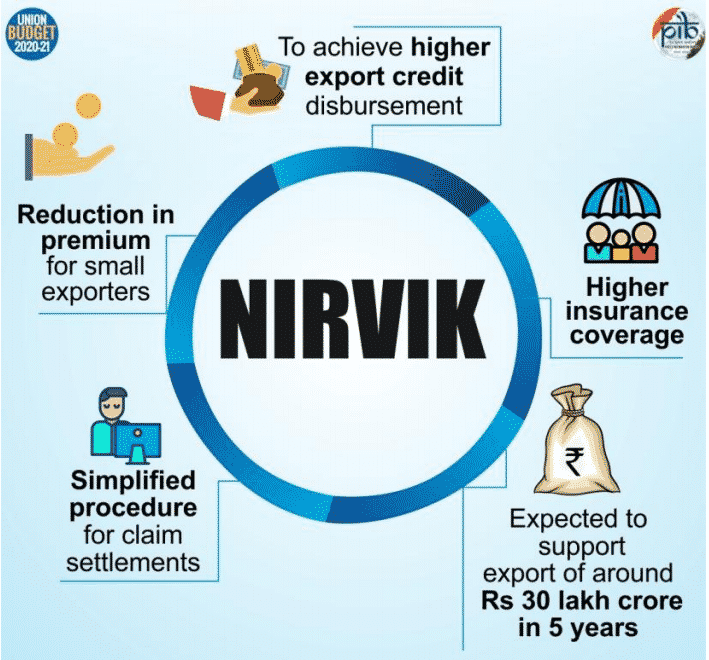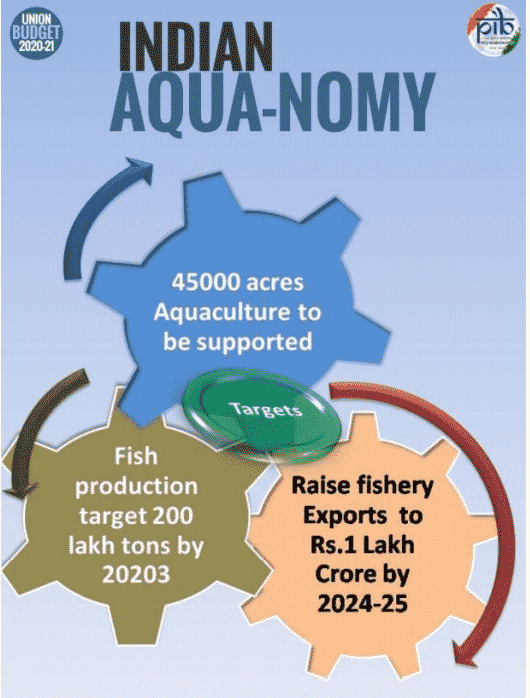Hello readers, this is a very important post for upcoming exams. We have collaborated all information of this year’s Union Budget 2020-2021 in a simplified way from official government websites. We urge you to read each and every point of the second budget of Narendra Modi led National Democratic Alliance (NDA) government’s second term.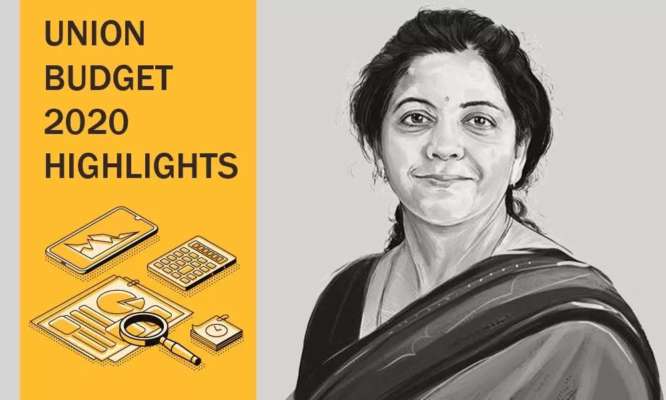
On February 1, 2020, Union Finance Minister Nirmala Sitharaman presented her second and 90th Union Budget of India for 2020-2021 (2020 Ke Lie Bharata Ka Keṃdriya Bajaṭa) in Parliament with an address to the speaker of Lok Sabha Om Birla, citing nominal GDP growth rate of 10% (i.e., real growth plus inflation) in 2020-21, which was 12% for 2019-20. The fiscal deficit target for the coming fiscal year starting April 1, has been fixed at 3.5 per cent. The aim of this budget is to boost incomes and enhance purchasing power.
- Expenditure: The government proposes to spend Rs 30,42,230 crore in 2020-21, which is 12.7% higher than the revised estimate of 2019-20.
- Receipts: The receipts (other than net borrowings) are expected to increase by 16.3% to Rs 22,45,893 crore, owing to higher estimated revenue from disinvestments.
- Deficits: Revenue deficit is targeted at 2.7% of GDP, which is higher than the revised estimate of 2.4% in 2019-20.
- Net market borrowings: For the year 2019-20 it would be 4.99 lakh crore and for the year 2020-21, it would be Rs 5.36 lakh crore.
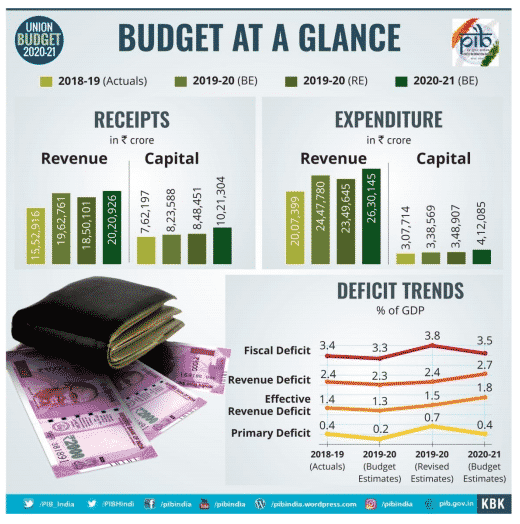
Before presenting the budget Sitharaman had recited a small verse in Kashmiri by Pandit Dinanath Koul. In English the verse means “Everything that we do, all of us do, is for this beautiful country”.
Point to be noted: Nirmala Sitharaman broke her own record and delivered the longest Union Budget speech by a Finance Minister of India i.e. 159 minutes long. Her first budget speech (2019-20) was 137 minutes long. She is also the only second woman to present the budget after Indira Gandhi presented in 1970-71. But she is the first full-time woman Finance Minister to present the Union Budget. Indira Gandhi held the additional charge of Finance when she was the Prime Minister.
Before heading towards the complete highlights of Union Budget let’s take a look on the documents that are presented to the Parliament, besides the Finance Minister’s Budget Speech. They are as follows:
A. Annual Financial Statement (AFS)
B. Demands for Grants (DG)
C. Finance Bill
D. Statements mandated under FRBM Act:
i.Macro-Economic Framework Statement
ii.Medium-Term Fiscal Policy cum Fiscal Policy Strategy Statement
E. Expenditure Budget
F. Receipt Budget
G. Expenditure Profile
H. Budget at a Glance
I. Memorandum Explaining the Provisions in the Finance Bill
J. Output Outcome Monitoring Framework
K. Key Features of Budget 2020-21
The documents shown at Serial Nos. A, B, and C are mandated by Art. 112,113 and 110 (a) of the Constitution of India respectively, while the documents at Serial No. D (i) and (ii) are presented as per the provisions of the Fiscal Responsibility and Budget Management Act, 2003. Other documents at Serial Nos. E, F, G, H, I, J and K are in the nature of explanatory statements supporting the mandated documents.
The Union budget 2020-2021 was presented on the basis of the following 3 prominent themes and dedicated to provide “Ease of Living” to all citizens.
[su_table]
| Themes of Union Budget 2020-2021 and Allocation towards them | ||
| Aspirational India Allocation- Rs 4,82,401 cr | Economic development for all Allocation- Rs 2,37,604 cr | Caring society Allocation- Rs 62,626 cr |
|
|
|
The above themes are held together by overarching themes
| ||
[/su_table]
Tables showing maximum allocation under Ministries and Schemes
[su_table]
Top 10 Ministries with Highest Allocation | ||
| Ministry | Headed by | Allocation for 2020-2021 (crore) |
| Ministry of Defence (MoD) | Rajnath Singh | Rs 4,71,378 (Highest) |
| Ministry of Home Affairs (MHA) | Amit Shah | Rs 1,67,250 |
| Ministry of Agriculture & Farmers’ Welfare | Narendra Singh Tomar | Rs 1,42,762 |
| Ministry of Consumer Affairs, Food and Public Distribution | Ram Vilas Paswan | Rs 1,24,535 |
| Ministry of Rural Development (MoRD) | Narendra Singh Tomar | Rs 1,22,398 |
| Ministry of Human Resource Development (HRD) | Ramesh Pokhariyal | Rs 99,312 |
| Ministry of Road Transport and Highway | Nitin Gadkari | Rs 91,823 |
| Ministry of Railways | Piyush goyal | Rs 72,216 |
| Ministry of Health and Family Welfare (MoHFW) | Harsh Vardhan | Rs 67,112 |
| Ministry of Housing and Urban Affairs (MoHUA) | Hardeep Singh Puri | Rs 50,040 |
[/su_table]
[su_table]
Top 3 Schemes with Highest Allocation | |
| Scheme | Allocation for 2020-2021 (crore) |
| Pradhan Mantri Kisan Samman Nidhi (PM-KISAN) | Rs 75,000 (Highest) |
| Pradhan Mantri Fasal Bima Yojana (PMFBY) | Rs 15,695 |
| Price Stabilisation Scheme (PSS) | Rs 2,000 |
[/su_table]
Let’s start with first theme of Union Budget 2020-2021:
1- Aspirational India – better standards of living with access to health, education and better jobs for all sections of the society.
Agriculture, Irrigation and Rural Development – Rs 2,83,202 cr
Under this, a 16 point action plan was listed with a Goal of Doubling farmers’ incomes by 2022. Agriculture credit target set for the year 2020-21 is Rs 15 lakh crore. For the sector comprising of Agriculture and allied activities, Irrigation and Rural Development an allocation of about Rs 2.83 lakh crore has been made for the year 2020-21. Its divided, inter-alia;
- For Agriculture, Irrigation & allied activities – Rs 1.60 lakh crore
- For Rural development & Panchayati Raj – Rs 1.23 lakh crore
The 16 points are as follows:
1. Encourage those State governments who undertake implementation of following model laws already issued by the Central government:
- a) Model Agricultural Land Leasing Act, 2016
- b) Model Agricultural Produce and Livestock Marketing (Promotion and Facilitation) Act, 2017;, and
- c) Model Agricultural Produce and Livestock Contract Farming and Services (Promotion and Facilitation) Act, 2018
2. Government is proposing comprehensive measures for 100 water stressed districts
3. Pradhan Mantri Kisan Urja Suraksha Utthan Mahabhiyan Scheme (PM KUSUM) will be expanded: Funds would be provided to 20 lakh farmers for setting up stand alone solar pumps while another 15 lakh farmers will be funded to set up grid-connected 15 lakh solar pumps. PM KUSUM scheme had unveiled in Feb 2019 with an outlay of Rs. 34,422 crore to add a solar capacity of 25,750 MW by 2022.
4. Balanced use of all kinds of fertilizers including the traditional organic and other innovative fertilizers.
5. Establishment of warehousing– On the lines with Warehouse Development and Regulatory Authority (WDRA) norms, govt will provide Viability Gap Funding for setting up efficient warehouses at the block/taluk level on a Public Private Partnership (PPP) mode. Food Corporation of India (FCI) and Central Warehousing Corporation (CWC) shall undertake such warehouse building on their land too.
- Mapping of warehousing- NABARD will be entrusted with mapping and geo-tagging of agri-warehouses across the country. Currently, India has an estimated capacity of 162 million MT of agriwarehousing, cold storage, reefer van facilities etc.
6. Village Storage Scheme– Govt will launch a ‘Village Storage Scheme’ to be run by women’s self-help groups (SHGs), with an aim to provide holding capacity for farmers. Apart from this, women belonging rural areas can will be able to retain their status as “Dhaanya Lakshmi”.
7. Setting up of “Kisan Rail”– To make the transportation of perishable goods (milk, meat, fish, etc) fast, Indian Railways will set up Kisan Rail through Public Private Partnership (PPP). There shall be refrigerated coaches in Express and Freight trains as well.
8. Setting up of Krishi Udaan: In order to assist farmers in transporting agricultural products, Krishi Udaan will be launched by the Ministry of Civil Aviation. This will immensely help improve value realisation (on agricultural products), especially in the north-east and tribal districts.
9. One product one district scheme: In order to promote horticulture, ‘one product one district ‘ has been mooted wherein one district will focus on one horticulture product.
10. Expansion of integrated farming systems in rainfed areas: Integrated farming systems in rainfed areas shall be expanded. The portal on “jaivik kheti” – online national organic products market will also be strengthened.
11. Integration of e-NWR with e-NAM– Financing on Negotiable Warehousing Receipts (e-NWR) has crossed more than`6000 crore. This will be integrated with e-National Agricultural Market (eNAM).
12. Expansion of NABARD re-finance scheme– Proposal to expand the NABARD refinance scheme has been given to cover Non-Banking Financial Company (NBFCs) and cooperatives that are active in agriculture lending. All eligible beneficiaries of the PM-Kisan scheme—that provides small and marginal farmers a minimum income support of up to Rs 6,000 crore—will also be eligible for the Kisan Credit Card scheme.
13. Elimination of foot and mouth disease by 2025– A goal has been set to eliminate foot and mouth disease, as well as brucellosis in cattle, peste des petits ruminants (PPR) in sheep and goats by 2025. Coverage of artificial insemination shall be increased from resent 30% to 70%. Also, Mahatma Gandhi National Rural Employment Guarantee Act (MNREGS) would be dovetailed to develop fodder farms.
- Aim- Doubling of milk processing capacity from 53.5 million MT to 108 million MT by 2025.
14. Blue Economy: Our government proposes to put in place a framework for development, management and conservation of marine fishery resources.
15. Fishery production & export to be raised: It has been proposed to raise fish production to 200 lakh tonnes by By 2022-23 and fishery exports to Rs 1 lakh crore by 2024-25.
16. Under Deen Dayal Antyodaya Yojana for alleviation of poverty, 58 lakh SHGs have been mobilised.
Wellness, Water and Sanitation- Rs 96,885 crore
- Allocation to the health sector– Rs 69,000 crore which includes Rs 6,400 Crore for Ayushman Bharat Pradhan Mantri Jan Arogya Yojana (AB-PMJAY).
- Allocation to Swachh Bharat Mission– Rs 12,300 crore
- Allocation to Jal Jeevan Mission– Rs 11,500 crore
– Viability Gap funding window for hospital establishment: It is proposed to set up Viability Gap funding window for setting up hospitals in the PPP mode. This would also provide large scale employment opportunities to youth. Proceeds from taxes on medical devices would be used to support this vital health infrastructure.
–Machine learning and AI will be used for delivering the Ayushman Bharat scheme
-Strengthening of “TB Harega Desh Jeetega” to end Tuberculosis by 2025.
-Expansion of Jan Aushadhi Kendra Scheme to all districts offering 2000 medicines and 300 surgicals by 2024.
Education and Skills- Rs 1,02,314 crore
- Allocation to education sector– Rs 99,300 crore
- Allocation for skill development– Rs 3,000 crores
Important announcements regarding education:
- New Education Policy By 2030: India is set to have the largest working-age population in the world. In this regard The New Education Policy will be announced soon.
- Initiation of degree level full-fledged online education programme: To provide quality education to students of deprived section of the society as well as those who do not have access to higher education This shall be offered only by institutions who are ranked within top 100 in the National Institutional Ranking framework.
- Establishment of IND-SAT examination: Under the government’s Study in India programme an IND-SAT exam is proposed for Asian and African. Now foreign students have to clear the IND-SAT exam to study in India
- National Police University and a National Forensic Science University are being proposed in the domain of policing science, forensic science, cyber-forensics etc.
- Conversion of district hospitals into medical colleges: To address the shortage of qualified doctors, it has been proposed setting up of medical colleges in existing district hospitals under the PPP mode. Also govt will encourage large hospitals with sufficient capacity to offer resident doctors Diploma and fellow of National Board (DNB/FNB) courses under the National Board of Examinations.
- Designing of Special bridge courses: Special bridge courses would be designed by the Ministries of Health, Skill Development together with professional bodies to bring in equivalence in the skill sets of the workforce and employers’ standards abroad.
- About 150 higher educational institutions will start apprenticeship embedded degree/diploma courses by March 2021.
- A program to provide internship opportunities to fresh engineers for a period up to 1 year by urban local bodies across the country will be started.
2 – Economic Development for all – “Sabka Saath,Sabka Vikas , Sabka Vishwas”.
It is divided in Industry and Commerce, Infrastructure, and Energy
Industry, Commerce and Investment- Rs 27,227 crore
- Setting up of Investment Clearance Cell – To provide “end to end” facilitation and support related to land banks and facilitate clearances at Centre and State level. It will work through a portal.
- Proposal of National Technical Textiles Mission– To position India as a global leader in Technical Textiles, a National Technical Textiles Mission is proposed with a four-year implementation period from 2020-21 to 2023-24 at an estimated outlay of Rs 1480 crore.
- Initiation of NIRVIK (Niryat Rin Vikas Yojana)– To achieve higher export credit disbursement, a new scheme, NIRVIK is being launched, which provides for higher insurance coverage, reduction in premium for small exporters and simplified procedure for claim.
- Launching of Scheme for Reversion of duties and taxes on exported products– It is proposed to digitally refund to exporters, duties and taxes levied at the Central, State and local levels, which are not getting exempted or refunded under any other existing mechanism.
- Proposal to take Government e-Marketplace (GeM) turnover to Rs 3 lakh crores– GeM is creating a Unified Procurement System in the country for providing a single platform for procurement of goods, services and works.
- Development of five new smart cities: It is proposed to develop five new smart cities in collaboration with States in PPP mode. Such sites would be chosen that offer the best choices in terms of upcoming economic corridors; revitalisation of manufacturing activities; and Technology and the demands of aspirational classes.
- Proposal of encouraging manufacturing of mobile phones, electronic equipment and semi-conductor packaging. Details would be announced later.
- All ministries are instructed to issue quality standard orders on the lines of “Zero Defect-Zero Effect” manufacturing.
- To develop each District as an export hub.
Infrastructure- Rs 100 lakh crore to be invested over the next 5 years
Allocation towards Transport Infrastructure– Rs 1,69,637 crore
- Involve youth in start-ups– It is also proposed to direct all infrastructure agencies of the government to involve youth-power in start-ups. They will help in rolling out value added services in quality public infrastructure for citizens.
- Releasing of National Logistics Policy– A National Logistics Policy will be released soon, clarifying the roles of the Union Government, State Governments and key regulators. It will create a single window e-logistics market and focus on generation of employment, skills and making MSMEs competitive.
- Accelerating development of highways– This will include development of 2500 Km access control highways, 9000 Km of economic corridors, 2000 Km of coastal and land port roads and 2000 Km of strategic highways. Delhi-Mumbai Expressway and two other packages would be completed by 2023 . Chennai-Bengaluru Expressway would also be started. The National Highways Authority of India (NHAI) to monetise at least 12 lots of highway bundles of over 6000 Km before 2024.
- About Indian Railways– Proposal to set up a large solar power capacity alongside the rail tracks, on the land owned by the railways.
- Four station re-development projects and operation of 150 passenger trains would be done through PPP mode
- More Tejas type trains will connect iconic tourist destinations.
- High speed train between Mumbai to Ahmedabad would be actively pursued.
- 148 km long Bengaluru Suburban transport project at a cost of Rs 18600 crore, would have fares on metro model. Central Government would provide 20% of equity and facilitate external assistance up to 60% of the project cost.
- Achievements: 550 Wi-fi facilities commissioned, Zero unmanned crossings, 27000 Km of tracks to be electrified.
- Sea Ports- Government would consider corporatizing at least one major port and subsequently its listing on the stock exchanges. The Jal Vikas Marg on National Waterway-1 will be completed. Further, the 890 Km Dhubri-Sadiya connectivity will be done by 2022. Economic activity along river banks to be energised as per Prime Minister’s Arth Ganga concept.
- Airports: 100 more airports to be developed by 2024 to support Udaan scheme
Energy- Rs 40,740 crore
Allocation towards power and renewable energy sector- Rs 22, 000 crore
- It is proposed to expand the national gas grid from the present 16200 km to 27000 km
- Further reforms to facilitate transparent price discovery and ease of transactions.
- Electricity- Promote “smart” metering in all the States and Union Territories by replacing conventional energy meters by prepaid smart meters in the next 3 years.
New Economy- Rs 42,852 crore
Allocation to Bharatnet programme– Rs 6000 crore
- Rs.8000 crore proposed over five years for National Mission on Quantum Technologies and Applications.
- New Policy will be released to enable the private sector to build Data Centre parks throughout the country.
- Fibre to the Home (FTTH) connections through Bharatnet will link 100,000 gram panchayats this year.
- A digital platform would be promoted that would facilitate seamless application and capture of Intellectual Property Rights (IPRs).
- – Knowledge Translation Clusters would be set up across different technology sectors including new and emerging areas.
- Mapping of India’s genetic landscape– Two new national level Science Schemes to be initiated to create a comprehensive database.
- The government proposes to provide early life funding, including a seed fund to support ideation and development of early stage Start-ups.
3 – Caring Society – Both humane and compassionate.
It focuses on Women & Child, Social Welfare; Culture and Tourism and also on Environment and Climate Change
Women & Child, Social Welfare-Rs 53,876 crore
Allocation towards nutrition-related programmes: Rs 35600 crore
Allocation towards programs specific to women: Rs 28,600 crore
Allocation towards welfare of Scheduled Castes (SC) and Other Backward classes (OBC): Rs 85,000 crore
Allocation towards development and welfare of Scheduled tribes: Rs 53,700 crore
Allocation towards senior citizens and Divyang (differently-abled): Rs 9,500 crore
- Financial support for wider acceptance of technologies, identified by Ministry of Housing and Urban Affairs to ensure no manual cleaning of sewer systems or septic tanks, to be provided.
- Proposal to appoint a task force to present its recommendations on the ssue about age of a girl entering motherhood, in six months’ time.
Culture & Tourism- Rs 5,650 crore
Allocation towards Ministry of Culture: Rs 3,150 crore
Allocation towards tourism promotion: Rs 2,500 crore
- Proposes to establish an Indian Institute of Heritage and Conservation under Ministry of Culture with a status of deemed University
- Five archaeological sites would be developed as iconic sites with onsite Museums. They are: Rakhigarhi (Haryana), Hastinapur (Uttar Pradesh) Shivsagar (Assam), Dholavira (Gujarat) and Adichanallur (Tamil Nadu).
- Re-curation of the Indian Museum in Kolkata, announced by the Prime Minister in January 2020.
- Museum on Numismatics and Trade to be located in the historic Old Mint building in Kolkata.
- 4 more museums from across the country to be taken up for renovation and re-curation. Support for setting up of a Tribal Museum in Ranchi (Jharkhand).
- A maritime museum would be set up at Lothal, the Harappan age maritime site near Ahmedabad, Gujarat by the Ministry of Shipping.
- State governments to develop a roadmap for certain identified destinations and formulate financial plans during 2021 against which specified grants will be made available to the States in 2020-21.
Environment & Climate Change- Rs 3,100 crore
Parameters for the incentives would be notified by the Ministry of Environment, Forests and Climate change. Allocation for this purpose is Rs 4400 crore for 2020-21.
- India submitted its Nationally Determined Contribution, under the Paris Agreement in 2015 on a “best effort” basis. Its implementation effectively begins on 1st January 2021.
- Thermal power plants that are old and their carbon emission levels are high above the pre-set norms are recommended for closure.
- States that are formulating and implementing plans for ensuring cleaner air in cities above one million to be encouraged.
4- Governance
This overarching theme is drived by Clean, corruption-free, policy driven, good in intent and most importantly trusting in faith.
- Amendments are proposed in companies act to build into statues, criminal liability for certain acts that are civil in nature.
- A sum of Rs. 100 crore allocated to begin the preparations for G20 presidency to be hosted in India in the year 2022.
- Development of Union Territories of J&K and Ladakh– An amount of Rs. 30,757 crore provided for the financial year 2020-21. The Union Territory of Ladakh has been provided with Rs. 5,958 crore.
- Establishment of National Recruitment Agency (NRA) for Non Gazetted posts– It is proposed to set up a National Recruitment Agency (NRA) as an independent, professional, specialist organisation for conduct of a computer-based online Common Eligibility Test for recruitment to Non Gazetted posts.
- Proposed to evolve a robust mechanism for appointment including direct recruitment to Tribunals and specialised bodies set up by govt for speedy disposal of commercial and other disputes.
- Strengthening of framework related to Contracts Act 1872.
- The proposed new National Policy on Official Statistics would use latest technology including AI.
5 – Financial Sector – Rs 40,433 crore
It is comprised of Banking, Insurance, Financial Market and Infra Finance
- Reforms accomplished in PSBs :
– 10 banks consolidated into 4.
– Rs. 3,50,000 crore capital infused - Deposit Insurance and Credit Guarantee Corporation (DICGC) has been permitted to increase Deposit Insurance Coverage for a depositor, which is now Rs 1 lakh to Rs 5 lakh per depositor.
- To strengthen the Cooperative Banks, amendments to the Banking Regulation Act are proposed for increasing professionalism, enabling access to capital and improving governance and oversight for sound banking through the RBI.
- NBFCs eligibility limit for debt recovery reduced– The limit for Non-banking financial companies(NBFCs) to be eligible for debt recovery under the Securitization and Reconstruction of Financial Assets and Enforcement of Security Interest (SARFAESI) Act 2002 is proposed to be reduced from Rs 500 crore to asset size of Rs 100 crore or loan size from existing Rs 1 crore to Rs 50 lakh.
- It is proposed to sell the balance holding of Government of India in IDBI Bank to private, retail and institutional investors through the stock exchange.
- Auto-enrolment in Universal Pension coverage.
- PFRDAI Act to be amended– Necessary amendments would be carried out in Pension Fund Regulatory Development Authority of India Act for its strengthening. It will also facilitate separation of NPS (National Pension System) trust for government employees from PFRDAI. This would also enable the establishment of a Pension Trust by the employees other than the Government.
- Necessary amendments to the Factor Regulation Act 2011– This will enable NBFCs to extend invoice financing to the MSMEs through TReDS, thereby enhancing their economic and financial sustainability.
- To introduce a scheme to provide subordinate debt for entrepreneurs of MSMEs. This subordinate debt to be provided by banks would count as quasi-equity and would be fully guaranteed through the Credit Guarantee Trust for Medium and Small Entrepreneurs (CGTMSE). The corpus of the CGTMSE would accordingly be augmented by the government.
- Window for MSME’s debt restructuring by RBI to be extended by one year till March 31, 2021. More than five lakh MSMEs have already been benefitted.
- An app-based invoice financing loans product will be launched to prevent the problem of delayed payments and consequential cash flows mismatches for the MSMEs
- Export promotion of MSMEs- Many mid-size companies are successful domestically but not in export markets. For selected sectors such as pharmaceuticals, auto components and others, it has been proposed to extend handholding support. A scheme of Rs 1000 crore will be anchored by EXIM Bank (Export–Import Bank of India) together with SIDBI (Small industrial Development Bank of India). Both these institutions would contribute Rs 50 crore each.
Financial Markets
- The limit for FPI in corporate bonds, currently at 9% of outstanding stock, will be increased to 15% of the outstanding stock of corporate bonds.
- To improve investors’ confidence and to expand the scope of credit default swaps, new legislation to be formulated for laying down a mechanism for netting of financial contracts.
- Government proposes to expand Debt-based Exchange Traded Fund (ETF) by floating a new Debt-ETF consisting primarily of government securities.
- To address the liquidity constraints of the NBFCs/HFCs, post the Union budget 2019-20, the government formulated a Partial Credit Guarantee scheme for the NBFCs. To further this support of providing liquidity, a mechanism would be devised.
Infrastructure Financing
- With the approval of the regulator, GIFT (Gujarat International Finance Tec) City would set up an International Bullion exchange(s) in GIFT-IFSC (International Financial Services Centre) as an additional option for trade by global market participants. This will enable India to enhance its position worldwide, create jobs in India and will lead to better price discovery of gold.
Disinvestment
- Government proposes to sell a part of its holding in LIC (Life Insurance Corporation of India) by way of Initial Public Offer (IPO).
Fiscal Management
For the FY 2019-20:
- Revised Estimates of Expenditure: at Rs.26.99 lakh crore
- Revised Estimates of Receipts: estimated at Rs.19.32 lakh crore.
For year 2020-21:
- Nominal growth of GDP estimated at 10%.
- Receipts: estimated at Rs.22.46 lakh cr
- Expenditure: at Rs.30.42 lakh cr.
Fiscal deficit of 3.8% estimated in RE 2019-20 and 3.5% for BE 2020-21. It
comprises two ingredients
- 3.3% for year 2019-20 and 3% for the 2020-21 budget estimate.
- Deviation of 0.5%, consistent with Section 4(3) of FRBM Act, both for RE 2019-
20 and BE 2020-21 - Market borrowings: Net market borrowings: Rs.4.99 lakh crore for 2019-20 and
Rs.5.36 lakh crore for 2020-21
Direct Tax
- Option introduced in Personal Income tax regime – In order to provide relief and to simplify the taxation regime, it is proposed to provide an option to individual and Hindu undivided family (HUF) to be taxed at following lower rates if they do not avail specified exemption/deductions. Around 70 of the existing exemptions and deductions (more than 100) to be removed in the new simplified regime.
[su_table]
| Total Income (Rs) | Current Tax Rate (%) | New Tax Rate (%) |
| Upto 2.5 Lakh | Exempt | Exempt |
| 2.5-5 Lakh | 5% | 5% |
| 5-7.5 Lakh | 20% | 10% |
| 7.5-10 Lakh | 20% | 15% |
| 10-12.5 Lakh | 30% | 20% |
| 12.5-15 Lakh | 30% | 25% |
| Above 15 Lakh | 30% | 30% |
| ||
[/su_table]
- Corporate tax rate– For new companies in the manufacturing sector the corporate tax reduced to 15%. Similarly, for the existing companies, the rate has also been brought down to just 22%. As a result, our corporate tax rates are now amongst the lowest in the world.
- Reduction in rate of Tax Deduction at Source (TDS)– In order to reduce litigation, it is proposed to reduce rate for TDS in case of fees for technical services (other than professional services) to 2% from existing 10% in order to align the same with the rate of TDS on works contract.
- MSMEs to boost less-cash economy:
– Turnover threshold for audit increased to Rs. 5 crore from Rs. 1 crore for
businesses carrying out less than 5% business transactions in cash.
- Dividend Distribution Tax– Currently, companies are required to pay Dividend Distribution Tax (DDT) on the dividend paid to its shareholders at the rate of 15% plus applicable surcharge and cess in addition to the tax payable by the company on its profits. It has been proposed to remove the Dividend Distribution Tax (DDT) and adopt the classical system of dividend taxation under which the companies would not be required to pay DDT. The removal of DDT will lead to estimated annual revenue forgone of Rs 25,000 Crore.
- Vivad se Vishwas Scheme– It is proposed to bring out a scheme for reducing the direct tax litigation. Taxpayers in whose case appeals are pending at any level can take the benefit from this scheme. Under the scheme, taxpayer would be required to pay only the amount of the disputed taxes and there will be complete waiver of interest and penalty provided they make payment by 31st March, 2020. For disputed penalty, interest and fee not connected with the disputed tax, the taxpayer would be required to pay only 25% of the same for settling the dispute. A tax payer shall be required to pay 110% of the disputed tax and 30% of penalty, interest and fee in case of payment after 31st March, 2020.
- Concessional tax rate for Electricity generation companies: Concessional corporate tax rate of 15% to new domestic companies engaged in the generation of electricity has been proposed. Earlier it was offered to the newly incorporated domestic companies in the manufacturing sector which start manufacturing by 31st March, 2023.
- Tax concession for foreign investments- 100% tax exemption to the interest, dividend and capital gains income on investment made in infrastructure and priority sectors before 31st March, 2024 with a minimum lock-in period of 3 years by the Sovereign Wealth Fund of foreign governments including the wholly owned subsidiary of Abu Dhabi Investment Authority (ADIA).
- Incentives for IFSC, municipal bonds and offshore borrowing– The concessional rate of Tax Deductible at Source (TDS) at 5% currently available under section 194LC and 194LD for borrowing from overseas is proposed to be extended for three years to 30th June 2023. Further, specified municipal bonds would also be eligible for such concession on overseas borrowing. It is also proposed to provide that the withholding tax rate shall be four per cent on fresh overseas borrowing on or after the 1st day of April, 2020 but before the 1st day of July, 2023 which is listed only on a recognised stock exchange located in any IFSC.
- Start-ups- To ease the burden of taxation on the employees it is proposed to defer the tax payment by five years or till they leave the company or when they sell their shares, whichever is earliest.
– An eligible Start-up having turnover up to 25 crores is allowed deduction of 100% of its profits for three consecutive assessment years out of seven years if the total turnover does not exceed 25 crore rupees.
– It has been proposed to increase the turnover limit from existing Rs 25 crore to Rs 100 crores.
– Apart from this, the period of eligibility for claim of deduction has also been extended from the existing 7 years to 10 years.
- Concessional tax rate for Co-operatives– It is proposed to provide an option to cooperative societies to be taxed at 22% plus 10% surcharge plus 4% cess, if they do not avail certain specified deduction/exemption. Further, it is also proposed to exempt these cooperative societies from Alternative Minimum Tax (AMT) just like companies under the new tax regime are exempted from the Minimum Alternate Tax (MAT).
- Medium, Small and Micro Enterprises (MSME)- Currently, businesses having turnover of more than Rs 1 crore are required to get their books of accounts audited by an accountant. Now to reduce the compliance burden the turnover threshold for audit has been raised to Rs 5 crore.This increased limit will apply only to those businesses which carry out less than 5% of their business transactions in cash.
- Affordable housing- Currently, an additional deduction up to one lakh fifty thousand rupees is allowed for interest paid on loans sanctioned upto 31st March, 2020 for purchase of an affordable house. In order to incentivise the purchase of affordable housing, it is proposed to extend the date of sanction of loan to 31st March, 2021. Hence, this deduction will also be available in respect of housing loans sanctioned by 31st March, 2021.
In order to boost the supply of affordable houses in the country, a tax holiday is provided on the profits earned by developers of affordable housing project approved by 31st March, 2020. In order to promote the affordable housing projects, it is proposed to extend the date of approval of affordable housing projects for availing this tax holiday by one more year i.e 31st March, 2021.
- For charity institutions– Pre-filling in return through information of donations furnished by the done. Process of registration to be made completely electronic. Unique registration number (URN) to be issued to all new and existing charity institutions. Provisional registration to be allowed for new charity institutions for three years.
- CBDT to adopt a Taxpayers’ Charter- Direct tax body Central Board of Direct Taxes (CBDT) will adopt a “taxpayer charter” which will ensure trust between a taxpayer and the administration and reduce harassment.
- Indian Stamp Act, 1899– Stamp duty will not be charged in the case of transactions in stock exchanges and depositories established in international financial centers set up under the Special Economic Zones Act, 2005.
- Widening the definition of “business trust”- In order to encourage unlisted Infrastructure Investment Trust (InvIT) or a Real Estate Investment Trust (REIT), it is proposed to extend the same taxation regime as available to listed InvITs and listed REIT to unlisted REIT and InvIT.
- Limit on exemption of Employer’s contribution to certain funds– It is proposed to put an upper cap of Rs 7,50,000 in a year on tax exempt employer’s contribution in recognized provident fund, superannuation fund and NPS in the accounts of an employee.
- Faceless appeal- it is proposed to provide enabling power for launching of Faceless appeal on the lines of Faceless assessment to eliminate human interface from the system
- Widening the scope of Dispute Resolution Panel(DRP)– It is proposed to widen the scope of references to DRP by including all non-residents 55 as eligible assessee and to clarify that all variation which are prejudicial to the assessee shall be within the scope of DRP.
- Proposal to reduce PIO time of stay– It is proposed to reduce the time of stay in India from 182 days to 120 days for an Indian citizen or person of Indian origin to become resident in India.
Indirect Tax
- GST (Goods and Services Tax) – Simplified return shall be implemented from the 1st April, 2020. This is under pilot run. It will make return filing simple with features like SMS based filing for nil return, return pre-filling, improved input tax credit flow and overall simplification.
– The total net GST target for the Centre has been pegged at Rs 6,90,500 crore for 2020-21 in the Union Budget.
– The union government has pegged compensation cess at Rs 110,500 crore in the Budget for 2020-21. This comes to Rs 9,208.3 crore a month on an average.
– Refund process has been simplified and has been made fully automated with no human interface.
– Dynamic QR-code capturing GST parameters proposed for consumer invoices
- Custom Duty– Customs duty raised on footwear to 35% from 25% and on furniture goods to 25% from 20%. While on Household goods and appliances, Electrical Appliances, Stationery items it has been increased from 10% to 20%. On toys it has been increased from 20% to 60%.
- 5% health cess to be imposed on the imports of medical devices, except those exempt from BCD
- Anti-dumping duty on Purified terephthalic acid (PTA), which is a raw material for synthetic textile is being abolished.
- It is proposed to raise excise duty, by way of National Calamity Contingent Duty on Cigarettes and other tobacco products. However, no change is being made in the duty rates of bidis.
Now, last but not the least, here is the static information about Union Budget of India.
Under the Article 112 of the Constitution of India, Union Budget is also known as Annual financial statement. The budget is presented by means of the Financial bill and Appropriation bill which has to be passed by the houses.
- Union Budget comes into effect from April 1.
- On November 26, 1947, the first Union budget of independent India was presented by R. K. Shanmukham Chetty.
- In 1951-52, C D Deshmukh was the first Indian governor of RBI who presented the Interim Budget.
- In 1958-59, Pandit Jawaharlal Nehru was the first PM who presented the Union Budget.
- In 1959, Morarji Desai, who became the finance minister of India, has presented the maximum number of budgets so far i.e. 10. He presented two budgets on his birthday – 1964 and 1968 as he was born on February 29.
- From 1970 to 1971, Indira Gandhi was the only woman Finance Minister who took over the Finance portfolio.
- Union Budget 1973-74 is known as “Black Budget” of India as budget deficit rose to Rs 550 crore.
- In 1997-98, P Chidambaram presented a Budget that was termed as “Dream Budget”.
- Jawaharlal Nehru, Indira Gandhi and Rajiv Gandhi are the only Prime Ministers to have presented a budget.
- In 1994, Manmohan Singh started the service tax.
- Till 2016, the budget was presented on the last working day of February.
- In 2017, the Rail budget was merged with the Union Budget.
- In 2019, Nirmala Sitharaman had ditched the British tradition of carrying a briefcase and adopted the Indian tradition by carrying a ‘bahi khata‘ (ledger). The budget documents were kept in a four-fold red cloth with the national emblem on it, wrapped with a ribbon.
Union Budget 2020 Infographic
